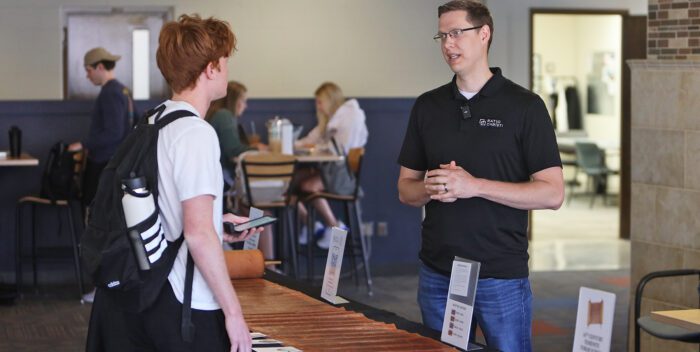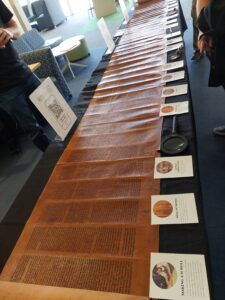Ratio Christi brings 84-foot Torah scroll to display in Janzow Campus Center
Representative Benjamin Blowers tells a student about the Torah scroll in Janzow Campus Center Top.
Photo credit: Tony Ways
By Kai Olbrich
Students and faculty of Concordia Nebraska were in awe of the brilliant craftsmanship and preservation of an 84-foot-long 16th-century scroll of the entire Torah, which was displayed at the Janzow Campus Center on April 16.
Concordia hosted the apologetics and evangelism organization Ratio Christi, which displayed the scroll from 11 a.m. to 1 p.m. According to Ratio Christi representative Benjamin Blowers, the scroll was written in the 1500s by Jews in Yemen.
“This particular scroll was written in the 1500s. So, so between 400 and 500 years ago. This one was written in a Jewish community in Yemen,” Blowers said. “It seems pretty reasonable to assume that it was probably brought from Yemen to Israel during the period of time when there was the relocation of Jews from around the world back to the state of Israel in the early 1950s.”
The scroll was written using an old form of Hebrew, which was unpointed, meaning there are no vowel indications in the writing.
“This is more of an ancient form of Hebrew,” Blowers said. “It’s unpointed, meaning it doesn’t have the vowel points for pronunciation. That’s typical of Torah scrolls. More modern Hebrew is going to have little dots surrounding the Hebrew letters. Or it’s going to be pointed to help with pronunciation.”
The scroll was written on scraped-down calfskin. That is one of the reasons why it has survived for hundreds of years.
“Most Torah scrolls were written on calfskin. This particular scroll is written on vellum, which is a very young calf. That would have been whose leather would have been used. So, it’s scraped down incredibly thin. The reason vellum or very young calfskin was desirable is because it’s very soft and very flexible,” Blowers said. “Part of the reason, likely why a scroll that’s this old has been preserved so well and lasted so long, is because it is so flexible and soft.”
Blowers believes that the scroll, and others like it, are valuable for both Christians and non-Christians to see that the Bible is reliable and has been faithfully carried throughout the centuries without changes being made.
“The scrolls provide a great opportunity to go on campuses or go into churches or youth groups to talk to students and other Christians and non-Christians about the confidence that we can have that Scripture has been transmitted reliably down through history,” Blowers said. “One of the objections that we get as Christians is often that myths and legends or errors have been copied into the text down through history. So even if the skeptic would say, or the non-Christian will often say, even if those religious or those original manuscripts were reliable or given by God, they’ve been corrupted over time. And so an artifact like this, along with the thousands of other Old and New Testament manuscripts that we’ve found, gives a strong body of evidence that we can evaluate and reasonably come to the conclusion and recognize that the scriptures have not been changed over time.”
Business professor Timothy Heidorn, after viewing the scroll, testified to the painstaking accuracy that the writers would have taken in copying down the words from the source material.
“There’s the obvious cultural thing, and that is, any copy made of holy scriptures must be exact, and you don’t make changes very easily. It’s not something that you interpret and write what you think. It’s word for word. And the only thing that I would assume could change would be more modern versions of Hebrew,” Heidorn said.
Freshman Lillian Loghry was impressed by the sheer size of the scroll as well as the craftsmanship it would have taken to create it.
“I mean, it’s massive. Think about how many hours it took to get that all. They didn’t have pens, and it just took a lot of resources, and it’s crazy,” Loghry said.
Heidorn believes that the Christian character of Concordia is special and gives opportunities to view artifacts like the scroll but also pointed out that other Abrahamic religions would take an interest in it.
“Needless to say, being at the university is always special because of our Christian character here,” Heidorn said. “But I would assume that this would also, for Jewish people and maybe less for Muslims, this would be something of significance to take.”





















